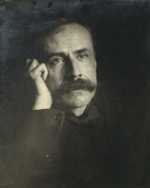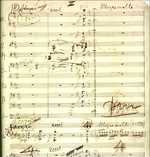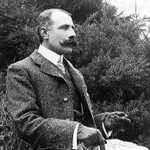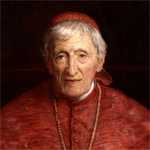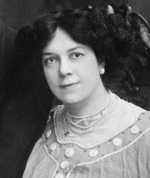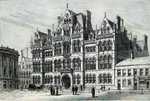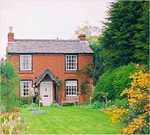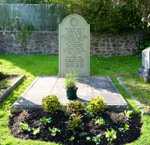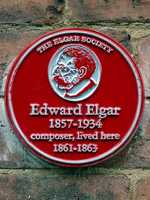1. Elgar’s Early Years and Education
Edward Elgar was born in Broadheath, near Worcester in the English West Midlands, on 2 June 1857.
Early life
Elgar’s father, William Henry Elgar, owned a music shop and tuned pianos. His mother, Ann, was the daughter of a farm labourer. He was the fourth of his parents’ seven children.
Elgar’s mother had converted to Roman Catholicism before his birth, and he was baptised as a Roman Catholic. His father, the organist of the St George's Roman Catholic Church in Worcester, did not approve of his wife raising the young Elgar as a Roman Catholic.
Education and early interest in music
Elgar attended Littleton House School, now Lyttleton, near Worcester up to the age of fifteen, where he was given a general education. His mother—who enjoyed the arts—encouraged him to appreciate literature and the countryside, and she supported his musical development.
All seven of the Elgar children were raised musically. In his father’s shop, the young Elgar taught himself to play a wide variety of instruments. By the age of eight he was taking both piano and violin lessons.
Elgar's father, who tuned the pianos of prominent members of Worcester’s community, took him along. In this way, the young Elgar started displaying his musical abilities to important people from a young age.
His talent as a composer shone through at the age of ten when he composed music for a piece that was written and acted by him and his siblings. Forty years later the music got known as The Wand of Youth suites, and he only had to make small changes to it at the time.
Early career
When Elgar left school in 1872, he went to work in the office of a local solicitor as a clerk.
He had dreams of furthering his musical studies at the Leipzig Conservatory in Germany —he even taught himself German to prepare for this—but his father could not meet the expense of sending him.
Elgar did not enjoy being a clerk, and he turned to reading and his music to escape the boredom of his position.
He started performing publicly as a violinist and organist at this time.
2. Elgar Starts Pursuing a Musical Career
Elgar left his job as a clerk after a few months to pursue a musical career, at which time he started giving musical lessons and working in his father's business sometimes.
Early musical career
Both Elgar and his father were members of the Worcester Glee club. As a member of this musical club he composed and arranged works, played the violin, accompanied singers and conducted for the first time. Around the age of 20, during brief visits to London, Elgar received more advanced violin lessons from esteemed Hungarian violinist Adolf Pollitzer.
Pollitzer believed that Elgar had the ability to become a prominent violin soloist, but Elgar doubted his own abilities in this field and he decided not to pursue this option.
In 1879 he became the conductor of the attendants' band at the Worcester and County Lunatic Asylum in nearby Powick at the age of 22. Doctors at the facility arranged a series of orchestral concerts and Friday night dances for the patients at the time.
For five years Elgar taught the band, and wrote and arranged their music; which gave him practical knowledge of the capabilities of a wide range of musical instruments.
Around the same time he was a professor of the violin at Worcester College for the Blind Sons of Gentlemen. Elgar also played the violin at the Worcester and Birmingham Festivals. In addition, he played the bassoon in a musical group alongside his brother Frank, who was an oboist. In this time Elgar reconceptualised pieces by famous composers, such as Mozart and Beethoven.
1880s
Elgar travelled to Paris in 1880 and Leipzig in 1882, where he got to attend prominent orchestra concerts. In Paris he heard French composer Charles-Camille Saint-Saëns play the organ.
He visited Helen Weaver, a friend who was studying at Leipzig Conservatory, and he got engaged to her. The engagement was broken off the following year, and the reason for this was not divulged. From 1883 to 1889 Elgar played the violin with English conductor William Stockley's orchestra to get more professional orchestral experience.
The first time a composition of Elgar's was performed by a professional orchestra, was when he participated in a performance of his Sérénade mauresque at Birmingham Town Hall in December 1883.
Elgar travelled to London regularly to try to get his works published, and during this period he battled financially and often became despondent.
Elgar gets married
On 8 May 1889 Elgar married one of his pupils, Caroline Alice Roberts, who was the daughter of distinguished Major-General in the British army. Alice's parents had both died in earlier years, and other members of her family were opposed to her marriage with Elgar. They disregarded him—eight years her junior— because he was the son of a tradesman, plus he was a music teacher who seemed unlikely to become successful.
Her family consequently disinherited her. Despite all this, Alice strongly believed in Elgar's abilities.
She was fiercely supportive of Elgar throughout her life, running their household and taking care of him. In addition Alice helped Elgar with his work by ruling bar lines on his score paper, and she often walked long distances to post his manuscripts and proofs—even in bad weather.
In 1896 she worked with him to compose Scenes from the Bavarian Highlands. The couple had one daughter, Carice Irene, who was born in 1890.
Hard times
After they got married, Elgar and his wife regularly attended concerts at the Crystal Palace in Hyde Park, London. This exposed him to a wide range of composers, such as French composer Louis-Hector Berlioz and German composer Richard Wagner.
Elgar's compositions did not draw much attention though. Sometimes he would find exciting opportunities, but then they would fall through. The highlight of Elgar's work at this time was when he was commissioned by the Worcester Festival Committee to compose a short piece for the 1890 Three Choirs Festival.
He composed Froissart, and he conducted the debut performance for it that year. Despite this small success, Elgar left London with his wife and daughter the following year due to a lack of work. The family settled in Great Malvern in Worcestershire, where Elgar conducted local musical groups and taught music.
3. Elgar Becomes a Successful Composer
In the 1890s Elgar’s style matured and he became more experienced.
1890s: Early successes
Froissart and other pieces composed by him in the 1890s—such as King Olaf, Caractacus and Imperial March—started growing his reputation beyond his hometown. Elgar wrote Imperial March to celebrate the Diamond Jubilee of Queen Victoria in 1897.
Other pieces by Elgar that were reasonably successful in the 1890s were The Black Knight and The Light of Life. In the 1890s he also wrote Serenade for Strings and Three Bavarian Dances.
In this time Elgar secured a publisher, Novello & Co, and he was noticed by eminent critics; but their reviews were not overwhelming at this stage. Elgar had enough work as a festival composer, but he was barely eking out a living. He felt quite despondent and unappreciated at this stage.
Variations on an Original Theme
Elgar's breakthrough came with the Variations on an Original Theme, familiarly known as the Enigma Variations, in 1899. With the Enigma Variations, Elgar's technical ability and style made it evident that he was greater than other prominent English composers of the time.
The Enigma Variations were premiered in London, conducted by the prominent musician Hans Richter. They were met with approval in Germany and Italy, and are still popular today.
They were followed by Elgar’s Sea Pictures and then The Dream of Gerontius, based on John Henry Newman's poem about a soul's journey through to its judgement and the afterlife. The debut performance of this piece at Birmingham, conducted by Richter in October 1900, was a failure due to an unprepared chorus that did not sing well.
Despite this, most of the critics recognised its greatness. Elgar was downcast following this piece’s initial failure, but a few days later he was writing again.
1900s
After The Dream of Gerontius Elgar wrote the successful Cockaigne that premiered in 1901. Between 1901 and 1930 Elgar composed the Pomp and Circumstance Marches, of which the first of the five became the most well-known. The first march was performed at a London Promenade Concert in 1901 under the baton of English conductor Henry J. Wood.
When this march was played, it received a double encore—the first time in the history of the Promenade that an orchestral piece was given a double encore. Elgar was commissioned to set A.C. Benson’s Coronation March for a gala concert to mark the coronation of Edward VII in June 1901, which resulted in The Land of Hope and Glory.
The Land of Hope and Glory was very popular, and became an unofficial British anthem. In the US, it is known as Pomp and Circumstance or The Graduation March, and since 1905 it has been adopted for almost all high school and university graduations.
The Dream of Gerontius was performed again in Düsseldorf in December 1901, and then again at the Lower Rhine Festival in May 1902; where it was performed under the baton of German composer Julius Buths. After the performance of this piece at this festival, German composer Richard Strauss declared that Elgar was the first English progressive musician.
As a Roman Catholic, Elgar was deeply touched by Newman’s poem. The Dream of Gerontius offended some Anglicans though, and it was banned by the Dean of Gloucester from his cathedral.
Between 1902 and 1914, Elgar was at the height of his popularity. In March 1904 a three-day Elgar festival was held at Covent Garden—the first time ever this honour was bestowed on an English composer, and the King and Queen attended the first and second concert.
In the South, an energetic new overture Elgar wrote after a visit to Alassio in Italy, was performed for the first time at the festival. At this time Elgar’s works were performed in both Europe and the US, and in July 1904 King Edward VII knighted him at Buckingham Palace. After Elgar was knighted the Elgars moved to a large house in Hereford, where they stayed until 1911.
Elgar performed a few times in the US in the early 1900s, and from 1905 to 1908 he was—reluctantly— Peyton Professor of Music at the University of Birmingham.
He was controversial in this role due to his criticism of English music, and he felt relieved to leave this post in 1908. In 1905 he released the Introduction and Allegro for Strings, which was an essay in string writing that was dedicated to Professor Samuel Sanford of Yale University.
The following year he composed The Kingdom, which was well-received. The Kingdom was the sequel to The Apostles that was first performed in 1903. Elgar’s First Symphony that was released in 1908 was a local and international success; and it was performed numerous times in Europe, Canada and the US.
In just over a year it was performed more than a hundred times in the UK and internationally. When it was performed first in Manchester, Richer referred to it as the greatest symphony of modern times.
1910s and First World War
Elgar’s Violin Concerto of 1910, which was a great success, was commissioned by leading international violinist Fritz Kreisler. In 1911 Elgar presented his Second Symphony; which was successful, but not as successful as the previous one.
In 1912 the Elgars moved to London and settled in a large house in Netherhall Gardens, Hampstead. Here Elgar composed The Music Makers and the symphonic study Falstaff, which were both received unenthusiastically.
Elgar was depressed by the First World War, but he felt compelled to support his fellow-countrymen. He wrote—and then withdrew—A Song for Soldiers. During the War Elgar joined the Hampstead Volunteer Reserve of the army. In this time he composed the patriotic Carillon and Polonia. His popular Land of Hope and Glory, which he had composed in 1901, became even more popular during the war.
During the war he also composed the music for a children’s play; as well as The Starlight Express, The Sanguine Fan, The Spirit of England and The Fringes of the Fleet.
Elgar’s health deteriorated towards the end of the war, and his wife rented them a house near Fittleworth in Sussex. Due to this Elgar’s health improved, and in 1918 he started finishing the first of four large-scale works: the Violin Sonata in E minor, the Piano Quintet in A minor, the String Quartet in E minor and the Cello Concerto in E minor.
The first three pieces were received enthusiastically, but the Cello Concerto in E minor had a failed premiere due to a judgment error by English conductor Abert Coates.
1920s
In the 1920s Elgar’s work was no longer fashionable. This did not deter his followers though, and they continued presenting his work.
Alice Elgar’s Death
Alice Elgar died after a short battle with lung cancer on 7 April 1920. After her death, Elgar sold their home and eventually settled down in Kempsey in Worcestershire, where he lived from 1923 to 1927.
Elgar battled to deal with his wife’s death, as she was his greatest supporter. To cope with her death, he spent a lot of time on his different hobbies. His hobbies included conducting chemistry experiments, watching football, attending horse races, cycling and being driven along the countryside by his chauffeur. In addition, he travelled to Brazil in late 1923.
Later work
Elgar lost a lot of his inspiration with his wife’s death. He visited London on occasion for conducting and other musical work though. In this time he made symphonic arrangements of works by German composers Johann Sebastian Bach and George Frederic Handel. In addition, he wrote his Empire March and a collection of songs called Pageant of Empire for the British Empire Exhibition in 1924.
Elgar—who has been described as the first composer to take the gramophone seriously—made recordings for some of his work at this time, a process which he had started in 1914.
Elgar's recordings were released on 78-rpm discs by recording companies His Majesty’s Voice (HMV) and RCA Victor. In 1928 Elgar seemed to regain his joie de vivre. He started working on an opera called The Spanish Lady and another symphony. In 1932 the BBC arranged a festival of his works to celebrate his 75th birthday.
He conducted the Violin Concerto for American musician Yehudi Menuhin in Paris in 1933.
4. Elgar’s Death & Legacy
In October 1933, during an operation, Elgar was found to have colorectal cancer.
He died on 23 February 1934 at the age of 76.
Elgar was laid to rest next to his wife at St Wulstan's Roman Catholic Church in Little Malvern.
English musician Percy M. Young collaborated with the BBC and Elgar's daughter after his death to produce a version of The Spanish Lady. His Third Symphony sketches were developed into a complete score by English composer Anthony Payne in 1998.
Besides being knighted in 1904, Elgar was awarded various titles and decorations both in the UK and internationally.
He was appointed a member of the Order of Merit in 1911. In 1928 he was made a Knight Commander of the Royal Victorian Order, and in 1933 he was promoted to Knight Grand Cross.
Elgar received honorary degrees from numerous universities both in the UK and the US, and he was made a member of various foreign academies.
The house where he was born became the Elgar Birthplace Museum in later years, and statues of him stand in different places in England. Elgar also appeared on an English banknote in the early 2000s.
Streets in the UK are named after him, and his has been honoured in numerous literary works and plays after his death.





